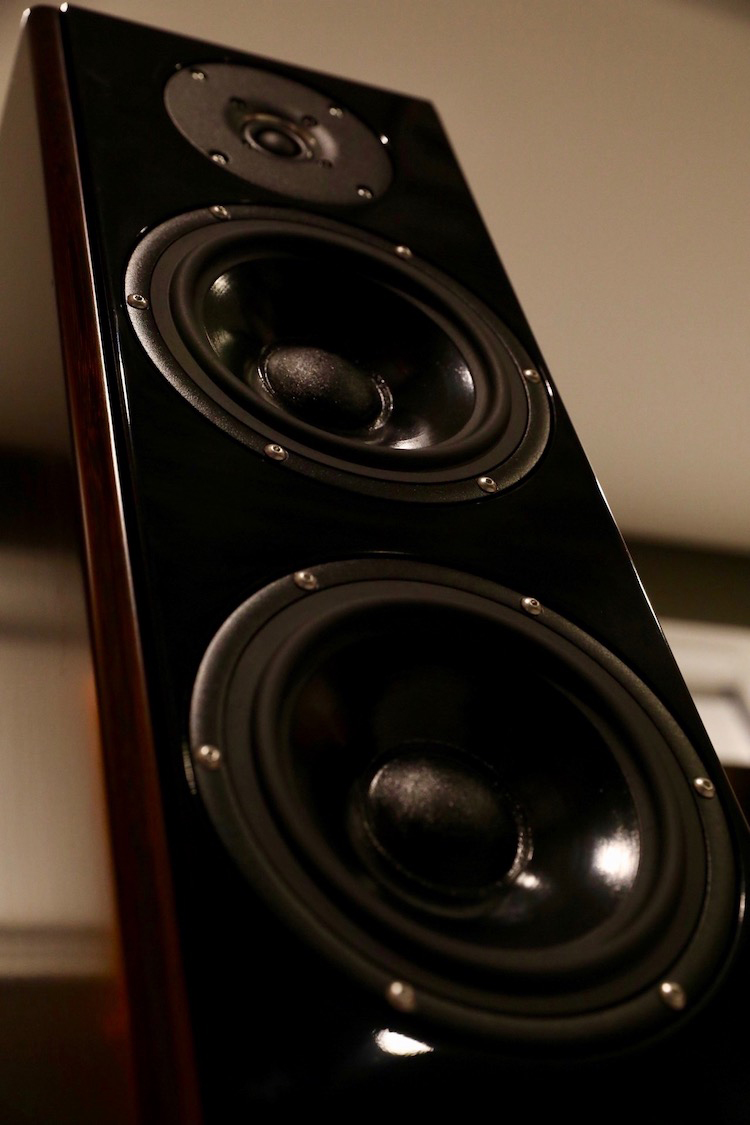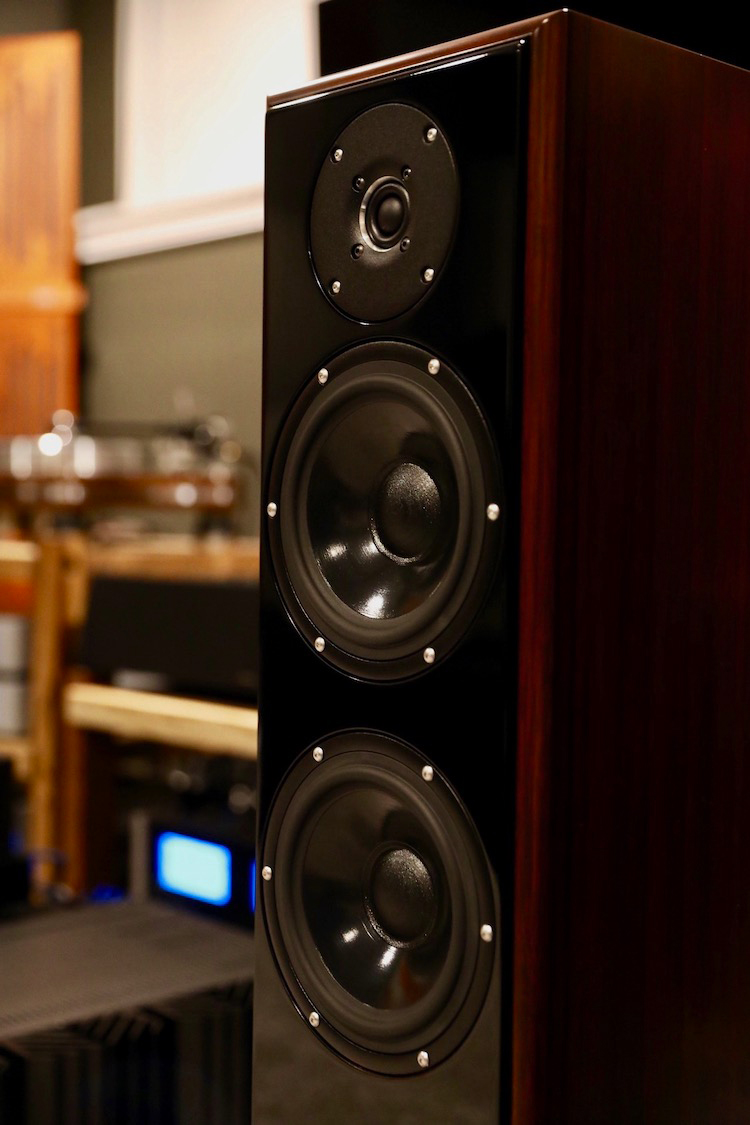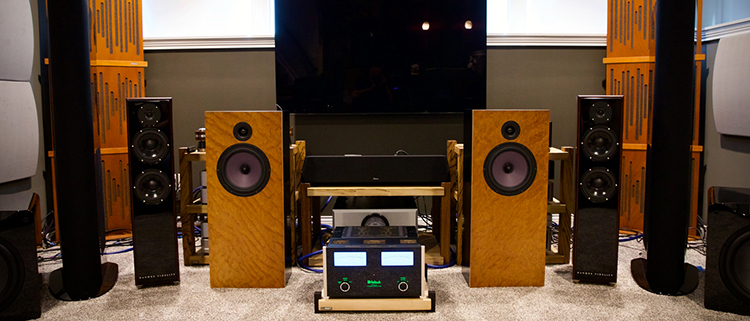
Given the size of the company and the relatively small selection of speaker models (just 6 at the time of this writing), I guess it would be fair to view DeVore Fidelity as a boutique-level speaker manufacturer. And with any type of boutique company, you can expect an artisan-approach that can’t normally be replicated in a big, high volume setting. The big companies get economies of scale and therefore can produce goods at lower price points, but they find it very difficult to achieve the type of craftsmanship that can be produced in lower volumes by the boutique companies.
The speaker designs by DeVore Fidelity range from the $3,900/pair 3XL bookshelf speakers, all the way up to their new O-Reference that sell for $88,000. But the focus of this review is on John DeVore’s gibbon Super Nine speakers that sell for $9,900.
DeVore Fidelity gibbon Super Nine Speaker
- 2.5-way design
- Slim profile doesn’t take up much floor space
- Easy to drive, and amplifier friendly
- Beautiful finish
- Incredible imaging!
- Made in Brooklyn, USA
My first real experience with DeVore Fidelity speakers came at the CES Show in Las Vegas. I had read plenty about how incredible John’s creations were, and that the DeVore rooms were notorious for having some of the best sound given his ability to get the most out of the less than ideal hotel rooms.
I knew that DeVore was showing off the new gibbon Super Nine speakers, so I wanted to make sure that I spent some time listening to his latest creations. What I didn’t expect, however, was that I would end up coming back to hear them multiple times. In my show report, I summed it up as follows:
This was the best sounding system I listened to all day. It had thunderous yet articulate bass, silky smooth mids, and crystal clear highs. For a price of $9,990, I think it’s a tremendous bargain. Not only do I plan to go back today for another listen, but I want to get my hands on a pair of these for review! Very impressive.
Before getting into too many details about the Super Nine speakers, let’s take a closer look at the company of DeVore Fidelity. Founded in 2000 by John DeVore, and based out of Brooklyn, NY, DeVore Fidelity has quickly established itself as one of the premier speaker designers and manufacturers in the business. With John’s background as a musician, he has carved out a niche in the industry by creating speakers that not only reproduce some of the best sounding music you’ve heard but also by designing visual works of art.
Frequency Response:
28Hz – 30kHz
Sensitivity:
91dB / W / M
Impedance:
8 Ohms, 6 Ohms minimum
Available Finishes:
Cherry Bamboo, Mahogany Bamboo, Mink Bamboo
Dimensions:
37”H x 8.5”W x 13.75”D (not including feet)
MSRP:
$9,990 / pair
Website:
Company:
SECRETS Tags:
DeVore Fidelity, Super Nine, Floorstanding Speakers, Speaker Review 2020
Secrets Sponsor
The DeVore Fidelity gibbon Super Nine speakers are a 2.5-way design, featuring two, 7” paper woofers and a .75” treated textile tweeter that was originally used in their flagship gibbon X ($15,890/pair). At just 37” tall and 8.5” wide, they are not very large speakers, and placement is a bit easier than their brethren Orangutan models in the DeVore lineup. The sides and top of the speakers are of very high-quality dyed bamboo, with the front faces being polished black. On the back of each speaker, you will find your standard binding posts.
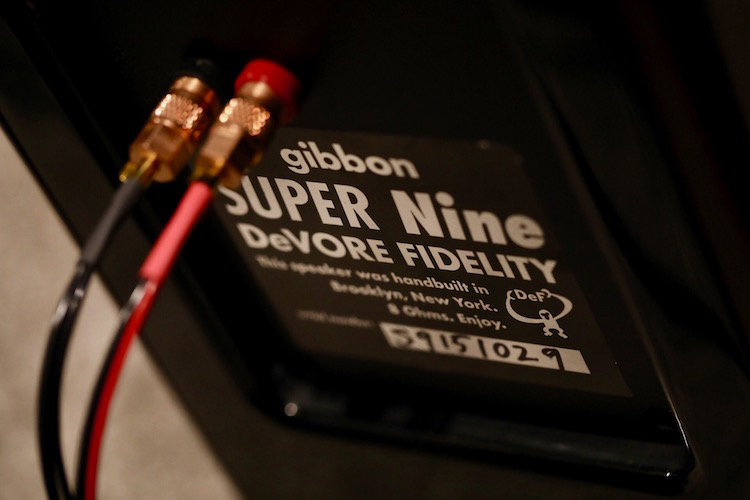
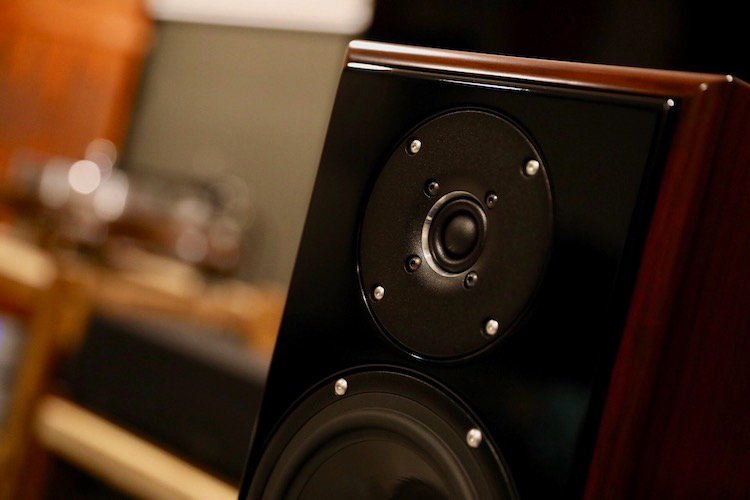
As for the Orangutan models from DeVore, they are 2-way speakers of very high sensitivity with 10-12 Ohm load impedance that were designed with low wattage tube-amps in mind. At $8,400/pair, the DeVore O/93 is extremely popular and highly acclaimed, with many reviewers in the audiophile world adopting them as their personal reference speakers.
So at $9,990, where do the gibbon Super Nines fit into the lineup, and why create a speaker with a price-point so close to the best-seller in the O/93? Well, I asked this exact question to John DeVore, and he explained that the two speakers have different sound profiles, and are aimed at different types of listeners altogether. Whereas the O/93 is designed for the fans of low wattage, single-ended triode (SET) amps, the Super Nines can be successfully driven by just about any type of amplifier on the market. Operating in the 10-12 Ohm impedance range, the O/93 may not sound as good when driven by big amplifiers that were designed to drive difficult loads.
As for the sound characteristics of the two speakers, the O/93 has a dynamic, live music quality about them. The Super Nines, on the other hand, are also dynamic but produce much better imaging and a wider, deeper soundstage. So despite the fact that they are close in price, they have different associated equipment requirements and go for people with different music reproduction tastes.
During my review period with the DeVore Fidelity Super Nines, I was fortunate enough to have a variety of amplifiers to choose from to get a better feel for their capabilities. And not only that, when I started to ask John DeVore about specifics on the differences between the Super Nines and the O/93’s, he was extremely generous and sent me a pair of the O/93’s as well so that I could make comparisons based off of real experience in my listening space.
For source components, I have a PS Audio BHK preamplifier, along with their stellar DirectStream DAC and DirectStream Memory Player. On the analog side, I had a VPI Prime Signature Turntable with Ortofon Cadenza Bronze MC cartridge, running through a Pass Labs XP-17 phono preamp. For amplification, I used a combination of the Pass Labs X350.8, McIntosh MC312, and a Line Magnetic LM845.
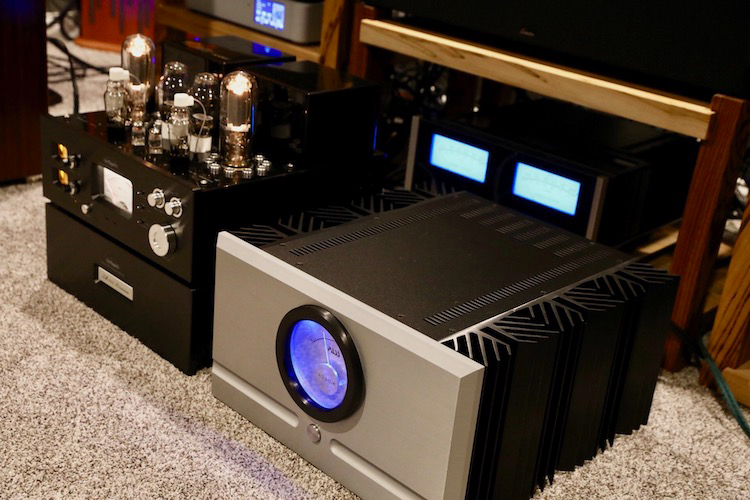
Pass Labs, McIntosh, Line Magnetic
Unlike my GoldenEar Triton Reference speakers, the DeVore Fidelity Super Nines don’t like much (or any) toe-in, so I knew that their placement would be a little different than my current setup. I spent a lot of time trying to figure out the proper placement of the Super Nines to get the best imaging and sound staging, and settled on closer together, and further away from the back wall than the big T-Refs. My final setup had them facing straight forward with no toe-in, just as John DeVore had recommended.
When I first got them into place, I have to admit that I wasn’t as excited about them as I was during the demo at CES. Was it the electronics that John was using in Vegas, was it room dimensions, or did I simply remember them being better than what they actually were? As a reviewer, we can’t draw a conclusion based on the first few seconds after hitting play, so I wasn’t about to write them off.
Instead of sitting down for immediate evaluation, I chose to let them play for a few weeks and listened more as background music than critical evaluation. I have found that some speakers don’t seem to change much from brand new to after hundreds of hours of break-in time, whereas some definitely need that time. After letting them play for a few weeks non-stop, and mixing up their use between music and home theater duties, I could definitely hear the Super Nines coming into their own.
My initial impressions were that the Super Nines were extremely musical speakers. That doesn’t mean that they were bloated in certain regions to give you the illusion of “great sound”, but at the same time, I wouldn’t call them dry or analytical, either. They fit somewhere nicely in between. I also found that I really enjoyed them at lower volumes as well, which is a bit rare for me. But when cranked up, they could handle dynamic swings as well as my Triton Reference, albeit with a little less low-end impact. But given that the Tritons have built-in 1800 watt subwoofers, I wouldn’t expect them to be the same.
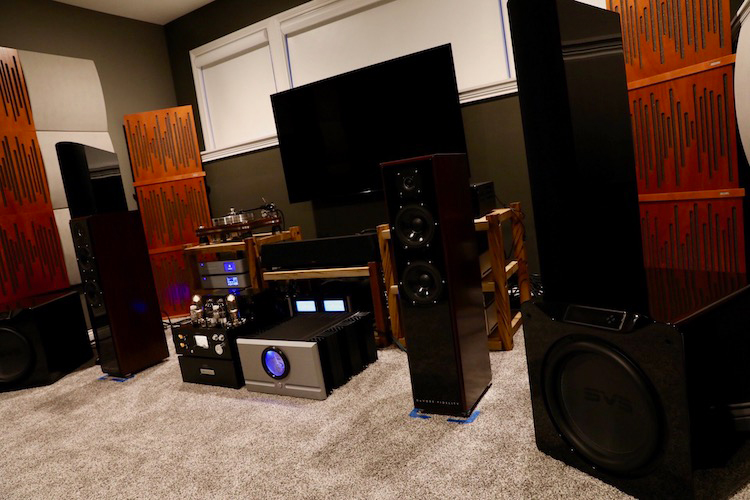
Another note that I wrote was on how dark and quiet the backgrounds were regardless of the music I was listening to. Having this quiet space between the notes really helps with the overall presentation, and you don’t really appreciate that until you listen to playback that achieves this.
But the most outstanding characteristics of the Super Nines were how they presented the soundstage and imaging of the music. They were monitor-like in their ability to throw a completely 3-dimensional soundstage that went way beyond the perimeters of the speakers themselves. At times I was able to hear instruments, voices, and effects fill the room in a manner that no other speakers have to this point.
Secrets Sponsor
I took turns swapping out the 3 amplifiers throughout the review period but finally settled on the McIntosh MC312 as my favorite of the bunch when teamed with the Super Nines. The LM845 was great but lacked the sheer force that I like when really pushing the speakers. My personal Pass Labs X350.8 did everything that I liked, but the McIntosh equaled the Pass Labs and bested it in low-volume listening. So for the majority of the review period, I kept the DeVores hooked up to the McIntosh.
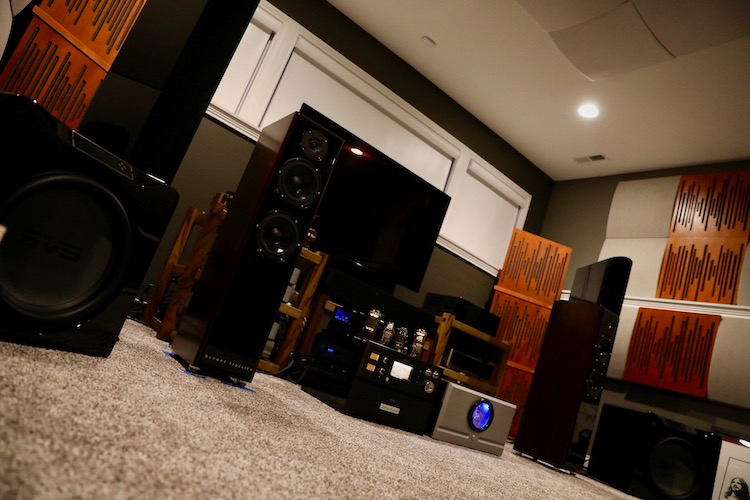
Now when comparing the sound of the Super Nines to that of the O/93, it was easy to see what John DeVore was out to accomplish. The O/93 has a sense of immediacy and a quick dynamic impact about them. As he stated, the “live dynamics” were in play that made them what I would call a “now” speaker…meaning that you have a great impression of them as soon as you sit down for a listen. I also found that I preferred the sound of them in more of a nearfield setting. My final placement for the O/93 was much closer together, and also much closer to my seating position than that of the Super Nines.
The Super Nines, on the other hand, have a tendency to sneak up on you a bit. They sound good when you first sit down in front of them, but they don’t have that immediate wow-factor that the O/93’s have. But after you spend some time with them, and really start listening to the nuances of the reproduction, it becomes apparent how incredible these speakers sound. And when you have space to really take advantage of the soundstage and imaging characteristics of the Super Nines, you quickly realize just how different of a speaker these are in comparison to the O/93.
As I went through some of my high-level notes, I picked up on a few that really didn’t require much specifics, or further details to sum up my feelings on the Super Nines:
- Low-level listening to jazz is the best I’ve heard.
- Dialectical Kid by Yello is absolutely spectacular at high levels, without a hint of strain.
- Come Together by Brian Bromberg is reference-quality!
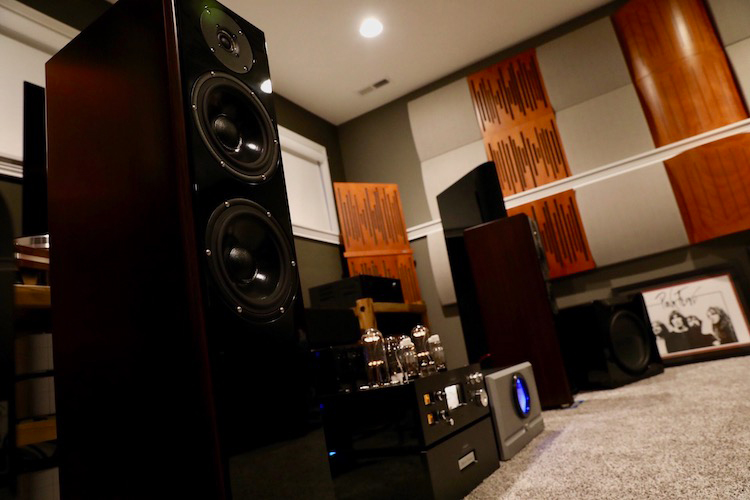
With speakers that provide such a huge soundstage like the Super Nines, and pinpoint imaging, I had no choice than to break out a recording that I have found over the years to provide the craziest placement of voices and effects, and that is Amused to Death by Roger Waters. Granted, since it was recorded in QSound (positional 3-Dimensional sound processing), it’s a bit of a cheater recording to get a sense of space. But over the years I have listened to this countless times in many different formats (LP, CD, SACD) and on many different systems, and have always found that there are degrees to which you sense the 3-dimensional recording.
But during the SACD playback through the Super Nines, I experienced exact placements that I had never heard before. At one point during my first listening session with this album, I even sent a text message to John DeVore telling him how spooky the imaging was. I was there to evaluate and review, but I was simply having so much fun that I completely forgot about my main objective.
When playing Perfect Sense Pt. 1, the thunder came from behind me, and then completely enveloped my listening position. On the Ballad of Bill Hubbard, the talking was coming directly from beside me (normally it’s to the side, but a little in front), with some of the effects coming from behind me. On Three wishes, the female voice was not only coming from directly to my side, but it seemed to extend beyond the wall. Creepy! And when the dog barks in that same song, it sounded like it was coming from one of the surround speakers behind me.
The Super Nines at times completely pulled a Houdini disappearing act, yet projected 3-dimensional images throughout the listening space. In all of the times I have heard this album on many different systems, and in my own space, I have never experienced such holographic musical reproduction.
Having this level of fun, and getting totally caught up in the music is what it is all about. For me personally, it’s not about specs or measurements, particularly when you’re referring to nuances about the reproduction that simply can’t be measured other than in smiles and goosebumps!

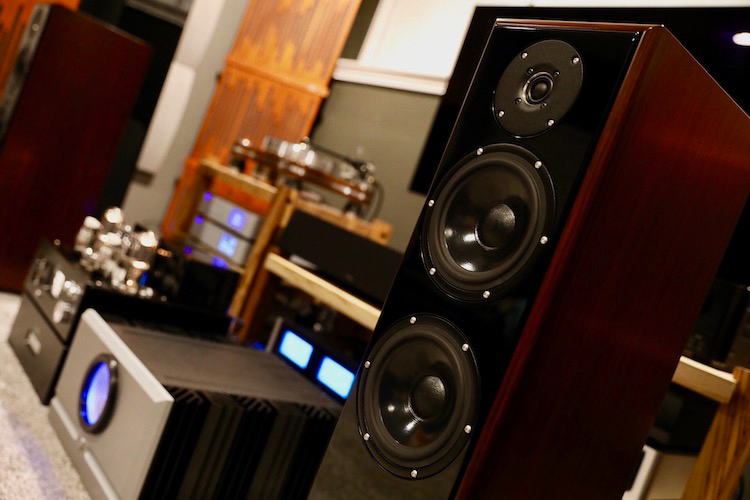
The DEVORE FIDELITY GIBBON SUPER NINE SPEAKERS are articulate, musical, and produce the best soundstage and imaging this reviewer has experienced!
- Small size, fewer space requirements
- Beautiful audio-furniture
- Incredible imaging and sense of space
- Made in the USA
- Just a little more bass
Just as musical preferences are highly individual, so can speaker selection be, given all of the different types of playback options possible. I may like my presentation to be big, bold, and dynamic whereas you may prefer yours to be more on the analytical side of the equation. That doesn’t make one of us right, and the other wrong, it just means that we are our own unique individuals.
So when it comes to determining whether a speaker is right for you, you should take reviews like this at face value, and realize it is based on my personal (and professional) opinion, and also based on what I like. In the end, nothing beats going to a brick and mortar audio store to evaluate and see if it fits into your particular wants and needs. No measurement, graph, chart, or even a review can tell you exactly what to expect as they are all mere data points that are waiting for you to piece together with your own experiences and tastes.
But with all things being equal, I can confidently tell you, my dear readers, that the DeVore Fidelity Super Nine speakers are of reference quality, and deserve all of the high praise that they can receive. If your musical interests and preferences include a relatively neutral playback, combined with a big soundstage and precision imaging, then you should do yourself a favor and find a way to demo the DeVore Fidelity gibbon Super Nine speakers!
Highly recommended.



